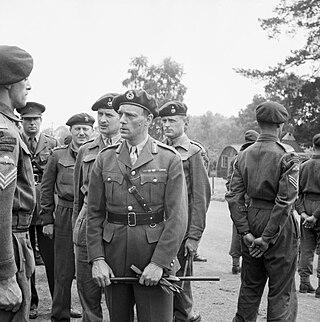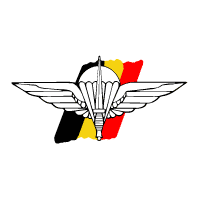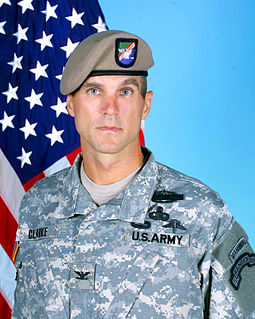
The Kommando Spezialkräfte (KSK) is the special forces military unit and a large brigade-level unit of the German Armed Forces (Bundeswehr) for special operations and commando warfare, reconnaissance, counterterrorism, combat search and rescue as well as military advisor. The KSK reports to the Rapid Forces Division (DSK) and is stationed in the Graf Zeppelin barracks in Calw, Baden-Württemberg.

The green beret was the official headdress of the British Commandos, a special-forces unit active during World War II. It is still worn by members of the Royal Marines after passing the Commando Course, and personnel from other units of the Royal Navy, Army and RAF who serve within 3 Commando Brigade and who have passed the All Arms Commando Course.

A parachutist badge is a military badge awarded by the armed forces of many states to soldiers who have received parachute training and completed the required number of jumps. It is difficult to assess which country was the first to introduce such an award.

The black beret is a colour of beret, a type of headgear. It is commonly worn by paramilitaries and militaries around the world, particularly armored forces such as the British Army's Royal Tank Regiment (RTR), the Royal Canadian Armoured Corps (RCAC), and Royal Australian Armoured Corps (RAAC) and the Indian Army Armoured Corps and Indian Border Security Force. Notable non-armored military units to wear the black beret include the non-military police and non-special forces elements of the Irish Defence Forces, MOD Guard Service, Russian Naval Infantry and Russian OMON units, the United States Air Force (USAF) Tactical Air Control Party (TACP), Philippine National Police-Special Action Force (PNP-SAF) members, and the Royal Canadian Navy. It was also worn by the United Kingdom's Royal Observer Corps (ROC) with their Royal Air Force (RAF) uniform, Metropolitan Manila Development Authority (MMDA).

Full dress uniform, also known as a ceremonial dress uniform or parade dress uniform, is the most formal type of uniforms used by military, police, fire and other public uniformed services for official parades, ceremonies, and receptions, including private ones such as marriages and funerals. Full dress uniforms typically include full-size orders and medals insignia. Styles tend to originate from 19th century uniforms, although the 20th century saw the adoption of mess dress-styled full-dress uniforms. Designs may depend on regiment or service branch. In Western dress codes, full dress uniform is a permitted supplementary alternative equivalent to the civilian white tie for evening wear or morning dress for day wear – sometimes collectively called full dress – although military uniforms are the same for day and evening wear. As such, full dress uniform is the most formal uniform, followed by the mess dress uniform.
The uniforms of the Canadian Armed Forces are the official dress worn by members of Canada's military while on duty.
This page details the uniforms and insignia of the Israel Defense Forces, excluding rank insignia. For ranks, see Israel Defense Forces ranks and insignia.

The uniforms of the British Army currently exist in twelve categories ranging from ceremonial uniforms to combat dress. Uniforms in the British Army are specific to the regiment to which a soldier belongs. Full dress presents the most differentiation between units, and there are fewer regimental distinctions between ceremonial dress, service dress, barrack dress and combat dress, though a level of regimental distinction runs throughout.

The Special Forces Support Group (SFSG) is a special forces unit of the British Armed Forces. The SFSG was formed officially on 3 April 2006 to provide support to the Special Air Service, the Special Boat Service and the Special Reconnaissance Regiment on operations. It is a tri-service unit, composed of the 1st Battalion, The Parachute Regiment, a company of Royal Marine Commandos, and a flight (platoon) from the Royal Air Force Regiment.

The maroon beret in a military configuration has been an international symbol of airborne forces since the Second World War. It was first officially introduced by the British Army in 1942, at the direction of Major-General Frederick "Boy" Browning, commander of the British 1st Airborne Division. It was first worn by the Parachute Regiment in action in North Africa during November 1942.
Special Forces of Zimbabwe are the units of the Zimbabwe National Army that operate as special forces. These forces have been deployed in several African conflicts, including the Mozambique Civil War and the Second Congo War.
The red beret is a military beret worn by many military police, paramilitary, commando, and police forces and should not be confused with the maroon beret worn by airborne troops all around the world.

The Special Operations Regiment is a special operations force of the Land Component of the Belgian Armed Forces. Its headquarters is located in Heverlee. It was known as the Light Brigade until 3 July 2018 when it was renamed and transformed into its current form.

In the United States (US) military, a beret flash is a shield-shaped embroidered cloth that is typically 2.25 in (5.72 cm) tall and 1.875 in (4.76 cm) wide with a semi–circular base that is attached to a stiffener backing of a military beret. These flashes—a British English word for a colorful cloth patch attached to military headgear—are worn over the left eye with the excess cloth of the beret shaped, folded, and pulled over the right ear giving it a distinctive appearance.

Troops began wearing berets as a part of the headgear of military uniforms in some European countries during the 19th century; since the mid-20th century, they have become a component of the uniforms of many armed forces throughout the world. Military berets are usually pushed to the right to free the shoulder that bears the rifle on most soldiers, but the armies of some countries, mostly within Europe, South America, and Asia, have influenced the push to the left.

The United States Army has used military berets as headgear with various uniforms beginning in World War II. Since June 14, 2001, a black beret is worn by all U.S. Army troops unless the soldier is approved to wear a different distinctive beret. A maroon beret has been adopted as official headdress by the Airborne forces, a tan beret by the 75th Ranger Regiment, a brown beret by the Security Force Assistance Brigades, and a green beret by the Special Forces.
This article describes the use of the beret as part of the uniform of various organizations. The use of the beret as military headgear is covered in a dedicated article, Military beret.
The 69 Commando ; also known as Very Able Troopers 69 is an elite multi-tasking special forces unit of the Royal Malaysia Police. The VAT 69 is based at Ulu Kinta, Perak and together with Special Actions Unit, they are part of Pasukan Gerakan Khas. The mission of 69 Commando is to conduct high-risk tasks such as counter-terrorism, hostage rescue, intelligence gathering and counter-insurgency within the borders of Malaysia.
The Special Forces and Elite Forces include both a specially and higher trained unit and a small percentage of personnel from a specific Malaysian military branch, law enforcement or government agency. In Malaysia, the term 'Special Forces' is widely used by uniformed services for special forces, special operations forces and 'special' trained units while 'Elite Forces' for units that more trained and capable combat. Regular personnel must undertake specialized and higher training to be able to join the units of the 'Special and Elite Forces'. These "Special Elite Forces" are denoted by different beret colours, shoulder tabs, unit patches, skill badges and uniforms.
The 21st Special Service Group is a command for Malaysian Army special forces, the Gerak Khas. The 21 SSG and 10th Parachute Brigade are elite fighting formations of the Malaysian Army. Both units are independent units under the Malaysian Army and report directly to the Chief of Army. The headquarters of the 21 SSG are at Iskandar Camp in Mersing, Johor.













